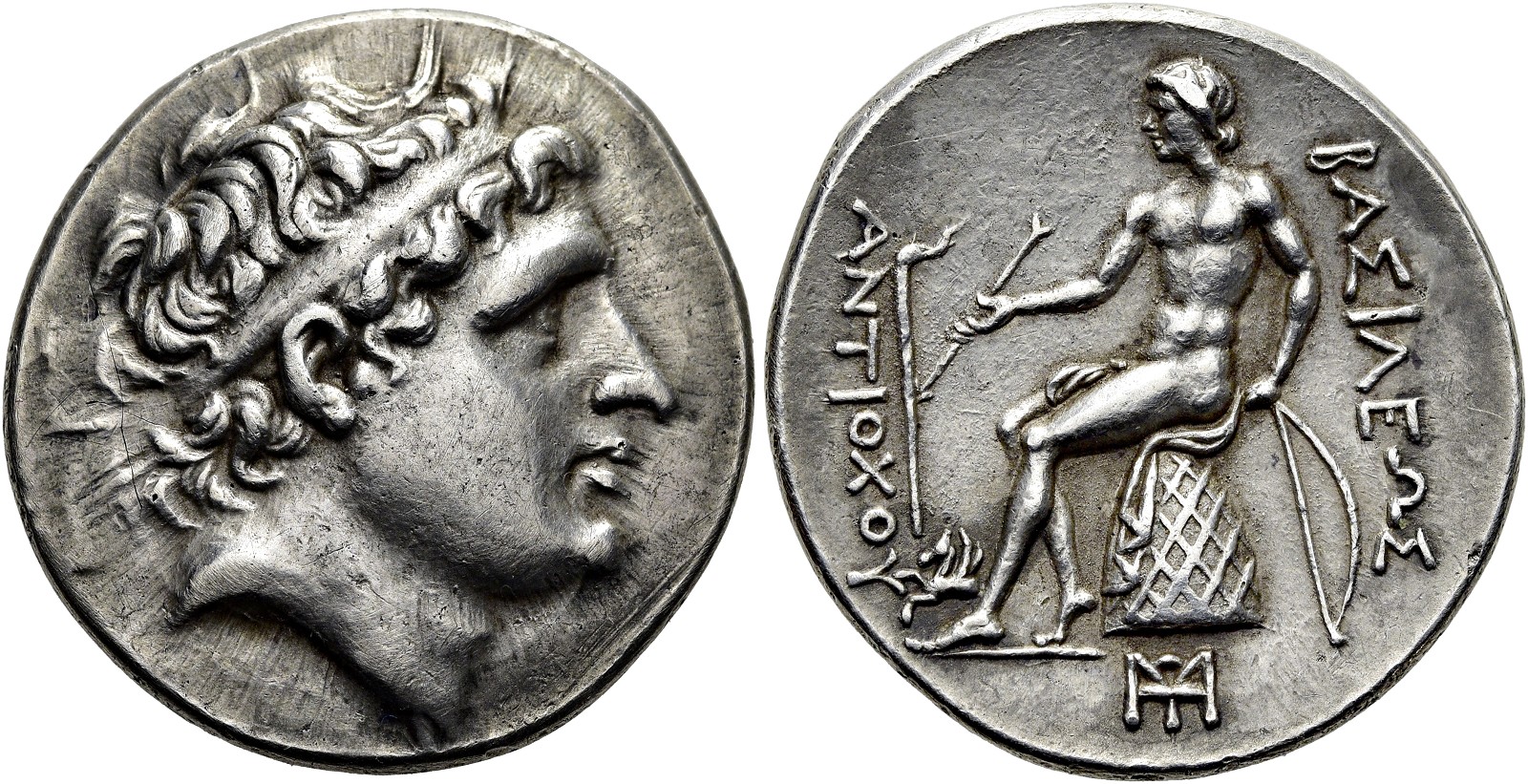Lampsacus (Antiochus Hierax), silver, tetradrachms (240-229 BCE)
From SILVER
240 BCE - 229 BCE Silver 6,542 kg
Description
| ObverseInscription or printing placed on the obverse.: | Diademed head of Antiochos I to right. |
| ReverseInscription or printing placed on the reverse.: | ΒΑΣΙΛΕΩΣ ANTIOXOY (Greek).Apollo seated left on omphalos, holding arrow in his right hand and resting his left on grounded bow |
Mint and issuing power
| MintIdentifies the place of manufacture or issue of a numismatic object.: | Lampsacus | Ancient regionAncient region.: | Mysia | Modern countryModern country: Turkey | AuthorityIdentifies the issuing power. The authority can be "pretended" when the name or the portrait of X is on the coin but he/she was not the issuing power. It can also be "uncertain" when there is no mention of X on the coin but he/she was the issuing power according to the historical sources: | Seleucid Dynasty (312-63 BC), Antiochus Hierax (Seleucid usurper, 246-227 BC) |
Chronology
| FromIdentifies the initial date in a range assigned in a numismatic context. | 240 BCE | toIdentifies the final date in a range assigned in a numismatic context.. | 229 BCE | PeriodTime period of the numismatic object.: Hellenistic 323-30 BC |
Physical description
| MetalThe physical material (usually metal) from which an object is made.: | Silver |
Median weightMedian of the weights of numismatic objects (in grams). in grams | 17.10 | DenominationTerm indicating the value of a numismatic object. Examples: tetradrachm, chalkous, denarius.: | tetradrachm |
StandardStandard.: | Attic |
Image

RQEMH 276 - Lampsacus, silver, tetradrachm, 240-229 BC.jpg [1]
References
| Die study referencePublication of the study: | Houghton 19781Houghton 1978 | ||
| Coin series referenceReference to coin series study: | Sear II2Sear II, n° 6918, RQEMH3RQEMH, n° 276, SC I4SC I, n° 848-856, HGC 95HGC 9, n° 399-403 | ||
| Coin series web referenceCoin series web references: | |||
Obverse dies distribution
| FrequencyFrequency of specimen in distribution. ᵖ | Number of obversesNumber of obverse dies. ᵖ (o) | % (o) | Number of coinsNumber of coins. (n) | % (n) | Die nameName(s) of the die(s). |
| 1 | 6 | 37.5 | 6 | 10.34 | 1, 3, 6, 13, 14, 16 |
| 2 | 2 | 12.5 | 4 | 6.9 | 4, 15 |
| 3 | 1 | 6.25 | 3 | 5.17 | 11 |
| 4 | 2 | 12.5 | 8 | 13.79 | 2, 9 |
| 5 | 1 | 6.25 | 5 | 8.62 | 10 |
| 7 | 1 | 6.25 | 7 | 12.07 | 12 |
| 8 | 2 | 12.5 | 16 | 27.59 | 7, 8 |
| 9 | 1 | 6.25 | 9 | 15.52 | 5 |
| Total | 16 of 16 | 100 | 58 of 58 | 100 |
Reverse dies distribution
no distribution is available
Quantification
| Number of obversesNumber of obverse dies. ᵖ (o) | 16 | Number of singletons (o1)The number of singleton coins. ᵖ | 6 |
| Number of reverse diesNumber of reverse dies. (r) | 40 | Number of coinsNumber of coins. (n) | 58 |
| Coins per obverse dieNumber of coins per obverse die. (n/o) | 3.63 | Coins per reverse dieNumber of coins per reverse die. (n/r) | 1.45 |
| Reverse per obverse ratioRatio of obverse dies divided by reverse dies. (r/o) | 2.5 | Percentage of singletons (o1)number of coins (n) divided by the number of singletons (o1) ᵖ | 37.5 % |
| Original number of dies (O) (Carter 1983 formula)The estimation of the number of coins according to Carter 1983 ᵖ | 19.13 | Coins struck if 20,000 as average productivity per dieCoins made if the average productivity for obverses (according to Carter) is 20,000. ᵖ | 382,600 |
| Original number of dies (O) (Esty 2011 formula)The estimation of the number of coins according to the singleton formula in Esty 2011 ᵖ (O) | 22.1 | Survival rate if 20,000 as average productivity per dieSurvival rate if average productivity is 20,000. ᵖ | 0.00015 |
| Coverage (o = % of O) (Esty 1984 formula)Esty 1984 - coverage (% of O) ᵖ (o = % of O) | 89.66% | Die productivity if survival rate 1/2,000Average productivity if survival rate is 1/2,000. ᵖ | 6,063.77 |
| Weight of silver (in kg) if 20,000 coins per die (O = Carter formula)Carter 1983 * Median weight * 20000 (*10 if gold or electrum) ᵖ | 6,542 kg <br /> 6,542 kg | Die productivity if survival rate 1/5,000Average productivity if survival rate is 1/5,000. ᵖ | 15,159.44 |
Remarks
Most likely one single workstation
References
- ^ Houghton, Arthur (1978), "The Seleucid Mint at Lampsacus", American Numismatic Society Museum Notes, 23, p. 59-68, pl. 8.
- ^ Sear, David R. (1979), Greek coins and their values. Vol. II, Asia and North Africa, London, xlviii, p. 317-762
- ^ Callataÿ, François de (1997), Recueil quantitatif des émissions monétaires hellénistiques, Numismatique Romaine, Wetteren, X + 341 p.
- ^ Houghton, Arthur - Lorber, Catharine (2002), Seleucid coins : a comprehensive catalogue. Part 1, Seleucus I through Antiochus III, New York - Lancaster - London, 2 v. (xxxviii, 488 p. + 300 p.), 101 pl.
- ^ Hoover, Oliver D. (2009), Handbook of ancient Syrian coins : royal and civic issues, fourth to first centuries BC, The Handbook of Greek Coinage 9, Lancaster, lxix, 332 p.